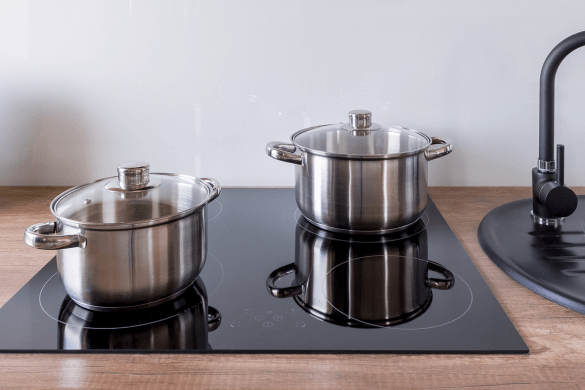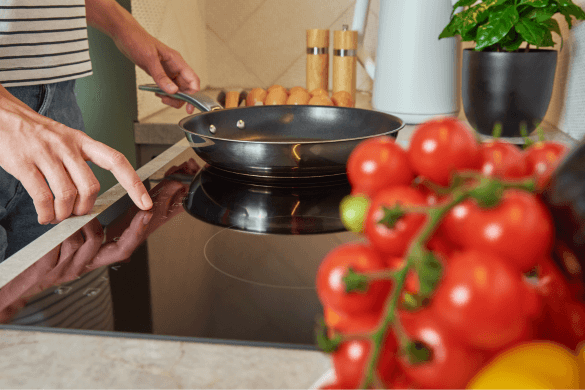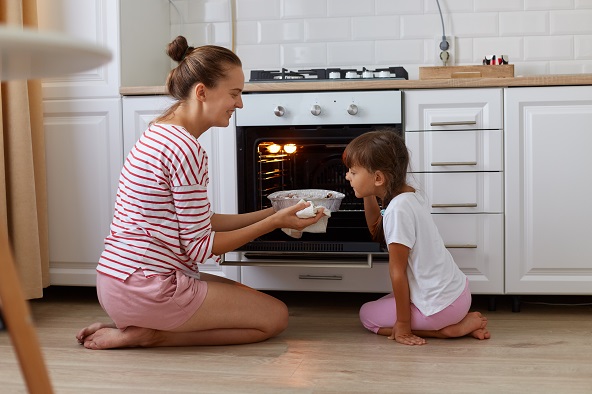Glass hobs look great and they’re easier to clean than a standard metal hob. But they can get damaged if you’re not careful. And leaving scratches on your induction hob isn’t ideal.
The good news is, you don’t just have to live with the damage or buy a new hob. We’ll explain how you can remove scratches with some simple materials and a little scrubbing.
Note: our advice here applies to glass-topped induction hobs only.
What causes scratches on induction hobs

By its nature, glass is more prone to scratches than the metal surface of a traditional hob. So it’s normal for a glass hob to develop some wear and tear over time (unless you never use it). The most common reasons that glass hobs get scratched are:
Wrong pots and pans
If you use cookware with a rough base, it can easily dig into the glass. This might not be obvious at first, but over time it will create visible scratches.
Sliding and dragging
You wouldn’t drag a metal object over a window or TV screen – because they’re easily scratched. The same applies to the glass on your hob.
Leaving spills to harden
When food or grease stick to your hob, you need to work harder to scrape them off. That makes it more likely you’ll accidentally scratch the glass. And if you put a heavy pot on dried food, that can also leave a mark.
Abrasive cleaning
Cleaning materials like steel wool, rough sponges and Brillo pads can all scratch glass.
How to fix scratched induction hobs
You might not be able to remove every mark completely (it depends how deep the scratch is). But you can get rid of lighter marks and make the deep ones less noticeable.
Before you start, make sure the hob is cold and switched off.
The materials you’ll need are:
- Glass hob cleaner
- Baking soda
- Non-scratch microfibre cloths
1. Clean the hob
It’s important to clean the surface first (otherwise you can’t get to the scratches properly). There are lots of hob cleaning sprays and fluids to choose from. Look at your hob’s user manual for any specific advice on which cleaner works best. A soft microfibre cloth is good for rubbing and wiping the cleaner off.
2. Mix baking soda and water

Baking soda is a mild alkali that’s cheap and safe to use. Put two teaspoons of baking soda in a bowl and add one teaspoon of water. Mix these into a paste with a spoon.
If you need more of the paste, you can make it to the same ratio. So whatever measure of baking soda you use, add half as much water. It should be about the same consistency as toothpaste.
Curious about other sustainable ways to make your kitchen sparkle? Read our guide to natural cleaning products.
3. Buff the scratches out with a cloth
This method works well for minor scratches and marks. And if baking soda isn’t available, you can also try this technique with toothpaste.
Spread your baking soda mixture over the scratched area. Then using a clean, soft cloth, rub the paste in gentle circles. Keep buffing it over the scratches for a few minutes.
4. Wipe away any residue
Finally, wipe away the baking soda with a damp cloth and dry the hob thoroughly. If the scratches haven’t disappeared, you can repeat the process.
For deeper scratches, you might need to use car, metal or glass polish. Put a few pea-sized drops of polish on the hob. Then buff it using a drill with a polishing attachment, or a sander with a polishing pad.
How to prevent scratches on your induction hobs

A glass hob needs a little more care than your average metal hob. But prevention is easier than cure. So here are some top tips for avoiding scratches on your hob.
Use the right cookware
Avoid heavy pots and pans, especially ones without a perfectly flat base. They’re more likely to scratch the surface than light pans with a wide, smooth base. Stainless steel cookware is typically recommended. And make sure the base is clean before use.
Don’t shake or drag pans
It’s tempting to give your pans a nudge while they’re cooking. But this is a sure way to scratch a glass hob. Instead, remember to only move what’s cooking, not the pan itself. If you need to move the pan, pick it straight up and put it straight down gently.
Wipe before and after use
Burnt-on food is hard and rough. So when you put a pan on it, the glass surface will take some damage. That’s why you should wipe the glass before putting anything on it. And clean it again when you’re finished, to stop food getting burnt on. For more detail, see our guide on how to clean your hobs.
Clean with the right products
For wiping up fresh spills, a clean microfibre cloth is best. You can buy lots of hob cleaning fluids to remove grease and stubborn dirt. But check your hob’s user manual first for advice on which cleaners to use. You can also use a non-scratch hob scraper to lift off hard crusts. Never use abrasive cleaners like steel wool or scouring pads.
Cook with a hob protector
You can also buy special mats for glass induction hobs which are safe to cook on. Placing your pans on these soft mats will make scratches much less likely.
Contact us if your hob needs repairing
If your hob is cracked, or you just can’t live with scratches, it can be replaced. We don’t recommend doing this yourself, unless you have the proper electrical qualifications. But we can get an engineer out to you, whether you have a plan with us or not. Book a hob repair.
Our blog is loaded with more related articles

Oven tips
How to clean your hobs
Find out the best way to clean your gas, induction, or ceramic hobs, including what products to use and how to avoid damaging t...
Read more

Oven tips
Electric or gas oven: the key differences
Find out the differences between electric and gas ovens, including their cooking performance, energy efficiency, maintenance re...
Read more

Oven tips
A guide to fan oven symbols and settings
Get to know your oven by understanding its symbols and the settings they represent. From fan oven programmes to cleaning...
Read more
